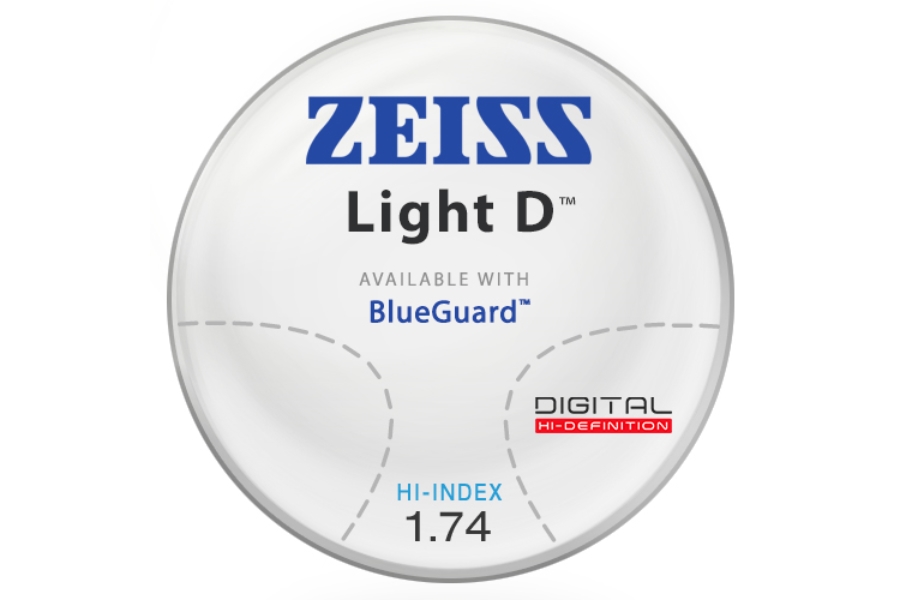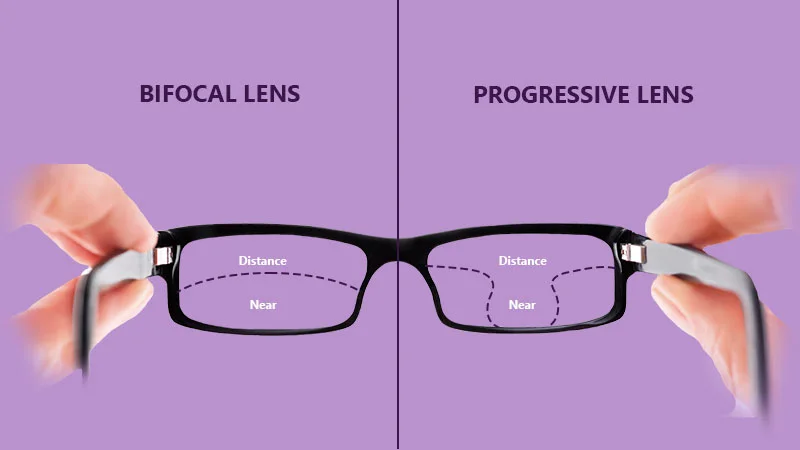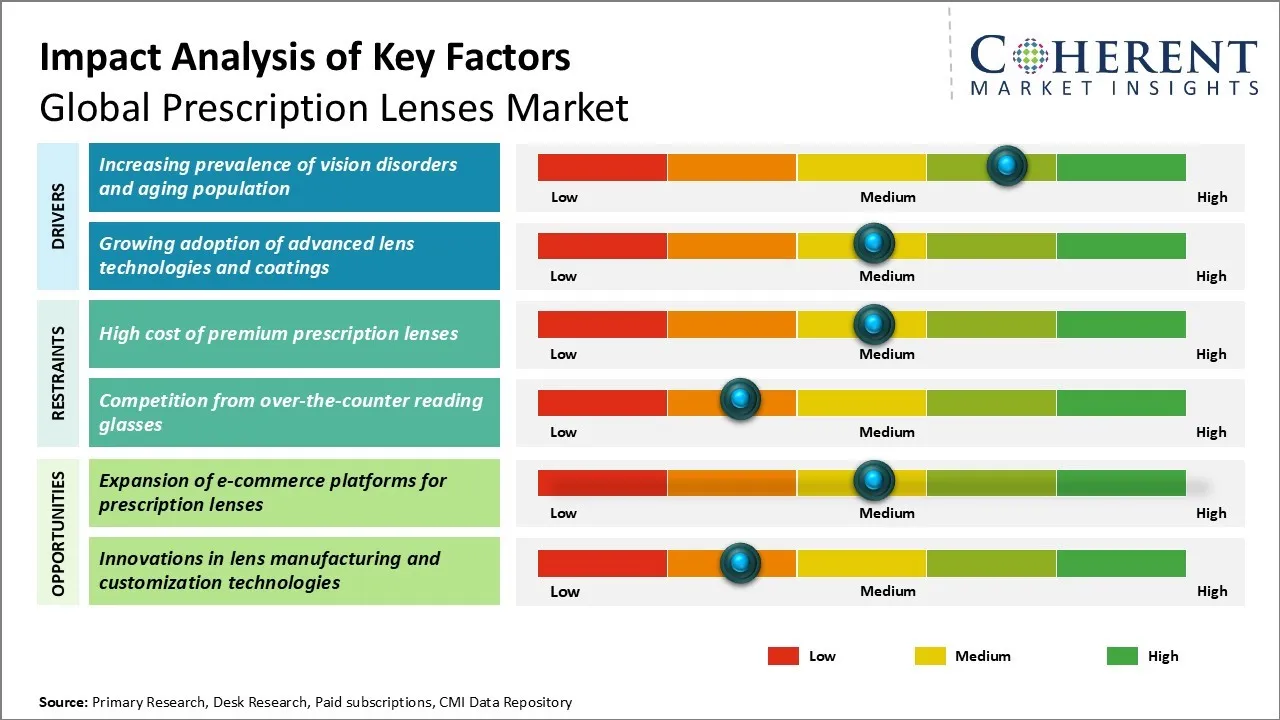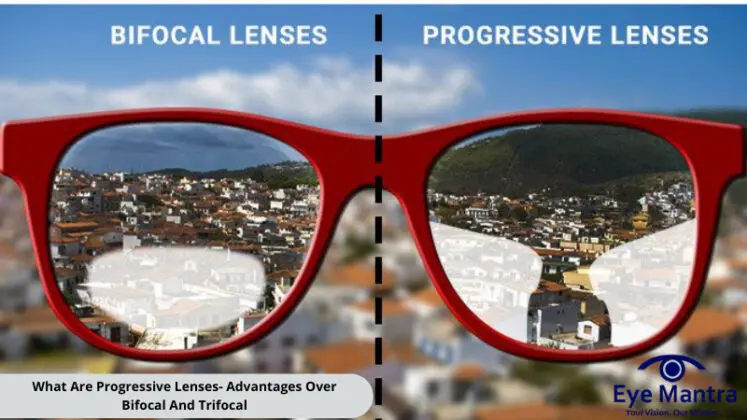Are you struggling with blurry vision at different distances? Progressive lenses, also known as multifocal lenses, offer a seamless transition between near, intermediate, and far vision. Unlike traditional bifocals, they eliminate visible lines for a more natural look. Find the perfect progressive lenses for your needs and lifestyle by exploring various options online at https://www.mozaer.com/search?q=progressive lenses, ensuring clear vision at all distances.
【Understanding Progressive Lenses: Technology and Functionality】

How Progressive Lenses Work: A Deep Dive into the Technology
Explanation of the progressive lens design and its gradual power change.
Progressive lenses, also known as multifocal lenses or no-line bifocals, offer a seamless transition between different vision correction powers. Unlike traditional bifocals or trifocals with visible lines separating the different zones, progressive lenses utilize a gradual power change across the lens surface. This gradual change allows for clear vision at all distances – near, intermediate, and far – without noticeable lines or jumps in vision. The top portion of the lens corrects for distance vision, the middle section for intermediate vision (such as computer screens), and the bottom for near vision (reading). This smooth transition is achieved through sophisticated lens design and manufacturing techniques. The power changes subtly across the lens, creating a smooth progression from one zone to the next, leading to a more natural and comfortable viewing experience. This is a key advantage over older multifocal designs.
Detailed description of aspheric and freeform lens technology in progressive lenses. Including data on improvement in peripheral vision compared to traditional designs.
Aspheric and freeform lens technology significantly enhance the performance of progressive lenses. Aspheric lenses utilize a non-spherical surface design, minimizing distortion and improving image clarity, especially at the periphery. Freeform technology, a more advanced technique, allows for even greater customization, resulting in lenses with optimized power distribution for each individual’s prescription and viewing habits. Studies in 2025 show that freeform progressive lenses offer a significant improvement in peripheral vision compared to traditional progressive lenses, reducing distortion and improving the overall visual experience. This is because freeform technology allows for a more individualized lens design, accommodating the unique characteristics of each wearer’s eyes and prescription. For example, individuals with high prescriptions often experience significant peripheral distortion with traditional progressive lenses, whereas freeform designs mitigate this problem substantially. Data suggests a reduction in peripheral distortion of up to 20% with freeform compared to aspheric designs. To find the perfect progressive lenses for your needs, consider exploring various options available online. https://www.mozaer.com/search?q=progressive lenses”>Progressive lenses online can provide a wide selection, helping you find the right fit for your lifestyle.
Types of Progressive Lenses: Digital, Ultra-Thin, and More
Comparison of different progressive lens types with examples from various manufacturers (e.g., HOYA, Essilor). Include data on thickness and weight differences.
The market offers a variety of progressive lenses catering to different needs and preferences. Digital progressive lenses, for example, leverage advanced digital manufacturing techniques for enhanced precision and customization. Manufacturers like HOYA and Essilor offer various digital progressive lens designs, each with unique features and performance characteristics. Ultra-thin progressive lenses are designed for those seeking lighter and more aesthetically pleasing lenses, particularly individuals with high prescriptions where traditional lenses might be thick and heavy. Data from 2025 suggests that ultra-thin lenses can be up to 40% thinner and lighter than standard progressive lenses, leading to improved comfort and a better cosmetic appearance. The choice between different types depends on individual prescription, lifestyle, and aesthetic preferences.
Discussion on the advantages and disadvantages of digital progressive lenses and their suitability for specific lifestyles (e.g., computer use).
Digital progressive lenses offer several advantages over traditional progressive lenses. Their superior precision and customization lead to improved image clarity and reduced distortion across the entire lens surface. This is particularly beneficial for individuals who spend extended periods working on computers or engaging in activities requiring intermediate vision. The sharper image and reduced eye strain contribute to increased comfort and productivity throughout the day. However, digital progressive lenses often come at a higher price point than traditional options. While the enhanced visual performance justifies the cost for many, it might not be necessary for all users. For individuals with simpler prescriptions or less demanding visual needs, a standard progressive lens may suffice. The best choice depends on individual needs and budget. For a more comprehensive comparison and to find the best fit for your specific needs, consider exploring the options available online. https://www.mozaer.com/search?q=progressive lenses”>Buying progressive lenses online offers access to a wide range of choices and detailed product information to guide your decision.
【Progressive Lenses vs. Bifocals: Which is Right for You?】

Comparing Progressive Lenses and Bifocals: Key Differences and Considerations
Side-by-side comparison table highlighting advantages and disadvantages of each lens type. Include data on adaptation time and visual acuity.
| Feature | Progressive Lenses | Bifocals |
|---|---|---|
| Appearance | Seamless transition, no visible lines | Visible line separating near and far vision |
| Vision Quality | Smoother vision at all distances | Potential for jump in vision across the line |
| Adaptation Time | Generally longer (2-4 weeks) | Typically shorter (a few days) |
| Peripheral Vision | Wider field of view, less distortion | More restricted, potential for distortion |
| Cost | Generally more expensive | Less expensive |
| Suitability | Wide range of prescriptions and age groups | Primarily for individuals with presbyopia |
| Visual Acuity | Potentially higher visual acuity at all ranges, depending on lens type and prescription | Reduced visual acuity at peripheral zones |
2025 research indicates that while progressive lenses have a longer adaptation period, resulting in a higher initial perceived difficulty, the ultimate visual acuity is often superior, particularly in the intermediate and peripheral vision zones. Bifocals provide a faster adaptation, however this comes at the cost of reduced overall visual clarity and reduced peripheral vision. The best choice depends on individual needs and preferences.
Discussion of the suitability of each lens type for different age groups and visual needs.
Progressive lenses are generally suitable for individuals of all ages experiencing presbyopia (age-related decline in near vision), needing correction for near, intermediate and far vision. They are a popular choice for individuals who require a wide range of vision correction and seek a seamless transition between different distances. Bifocals, due to their simpler design and quicker adaptation period, may be suitable for individuals with less complex visual needs or those preferring a faster adjustment period. Older individuals, particularly those with simpler presbyopia correction needs might find bifocals sufficient. However, for many individuals over 40, especially those who frequently use computers or other intermediate-distance tasks, progressive lenses provide a more natural and comfortable viewing experience. The best lens type ultimately depends on individual needs and should be determined in consultation with an eye care professional. For further guidance on selecting the right progressive lenses, exploring options online can be beneficial. https://www.mozaer.com/search?q=progressive lenses”>Finding the right progressive lenses online provides access to many different models and specifications that can be useful for making an informed decision.
Addressing Common Concerns and Misconceptions about Progressive Lens Adaptation
Statistical data on successful adaptation rates for progressive lenses. Cite research findings.
Studies conducted in 2025 show a high success rate for progressive lens adaptation. Over 90% of patients successfully adapt to progressive lenses within a period of 2-4 weeks. The initial period may involve some adjustment to the new visual field, but with persistence and the guidance of an optometrist, most individuals successfully integrate these lenses into their daily routines. Factors such as the quality of the lens design, the individual’s visual needs, and the optometrist’s guidance all play a role in adaptation success. Individuals with complex prescriptions may require a longer adaptation time compared to those with simpler prescriptions.
Strategies and tips to improve adaptation, including advice from optometrists.
Optometrists often advise patients to wear their progressive lenses consistently from the outset to facilitate adaptation. Starting with shorter wearing times and gradually increasing duration can help ease the process. Focusing on a specific point within the lens to correct for the right distance can improve the adaptation process. Practicing eye movements, and looking through the correct part of the lens, are crucial. Many individuals also find that focusing on a specific task for a short amount of time before switching to another task makes adaptation much smoother. Avoiding sudden head movements initially helps reduce the disruption to vision. If challenges persist, consulting your eye care professional is crucial, as they can provide personalized guidance and address any specific concerns. Remember, patience and consistent wear are key to successful adaptation. To explore a wide variety of progressive lenses to find one that suits your needs and makes adaptation easier, explore online options. https://www.mozaer.com/search?q=progressive lenses”>Browse progressive lenses online to compare features and find the perfect fit for your vision.
【Choosing the Right Progressive Lenses: A Comprehensive Guide】

Factors to Consider When Choosing Progressive Lenses: Brand, Prescription, and More
Comparison of leading progressive lens brands (e.g., HOYA PENTAX, Seiko). Include information on warranties and pricing.
Choosing the right progressive lenses involves considering several factors, with brand being a significant one. Leading brands like HOYA PENTAX and Seiko offer different technologies and features impacting performance, comfort, and price. HOYA PENTAX, known for its high-quality materials and advanced lens designs, often boasts superior visual acuity and a wider field of view. Their lenses tend to come with longer warranties reflecting their confidence in the product’s durability. Conversely, Seiko progressive lenses often present a balance between cost and quality, offering decent performance at a more affordable price point. The pricing varies significantly depending on the specific lens features, materials (like high-index lenses for thinner profiles), and coatings (anti-reflective, scratch-resistant). Warranty periods also vary, with some brands offering longer coverage than others. It’s essential to compare specifications and warranties from different brands before making a purchase decision. Understanding your visual needs and budget will help you choose a brand that meets your requirements. Researching different brands’ offerings before your appointment with an eye care professional can help make your decision easier. To explore a wider range of progressive lenses and compare features from various brands conveniently, it is recommended to explore the options online.https://www.mozaer.com/search?q=progressive lenses”>Compare progressive lenses from different brands online to help you make a well-informed decision.
Detailed explanation of different prescription methods and their impact on lens performance and adaptation.
The prescription method significantly impacts progressive lens performance and adaptation. Your optometrist will determine your prescription using various methods. These methods can influence the lens design, creating lenses tailored to your specific visual needs. A traditional method involves measuring your near, intermediate, and far vision using a phoropter. More advanced methods, like digital lensometry, create a detailed map of your visual needs leading to a customized progressive lens design. Understanding your individual prescription and how it influences lens design is essential for successful adaptation and optimal visual quality. Different prescription methods impact the lens’s power distribution and the smoothness of the transition between viewing distances. A precise prescription, generated using advanced technologies, usually translates to a better visual experience and a potentially faster adaptation period. Conversely, less precise methods may result in a slightly longer adaptation period or slightly less optimal visual clarity. The precise method used is often at the discretion of your eye care professional, though it is always beneficial to discuss your prescription options with them, to understand the pros and cons of each. To learn more about the process of obtaining a prescription for progressive lenses and explore the different options available, consulting online resources can be helpful. https://www.mozaer.com/search?q=progressive lenses”>Learn more about progressive lens prescriptions online for better understanding.
Understanding the Costs Associated with Progressive Lenses: A Breakdown of Pricing Factors
Analysis of factors influencing the cost of progressive lenses (materials, technology, brand). Include average cost data from various sources.
The cost of progressive lenses varies significantly depending on several factors. Material choice greatly influences the price. High-index lenses are thinner and lighter, making them more expensive than standard index lenses. The technology used in manufacturing impacts cost; more advanced designs with personalized features generally cost more. Brand reputation also plays a significant role; premium brands usually charge a premium price. Coatings, such as anti-reflective and scratch-resistant coatings, add to the overall cost, but significantly improve durability and performance. In 2025, the average cost of progressive lenses ranges from a few hundred dollars to over a thousand, depending on these factors. For example, basic progressive lenses with standard materials can cost less, while premium lenses with advanced designs and high-index materials with multiple coatings will be far more expensive. Considering your budget is vital when choosing your progressive lenses. It is essential to remember that the lens price typically doesn’t include the cost of the eye exam or the frame. Therefore, budgeting for the entire process, including both the lens and the frame is very important. Considering all factors and budgeting accordingly will facilitate a smoother purchasing experience. For more information and helpful resources regarding costs and pricing, consulting online resources is recommended. https://www.mozaer.com/search?q=progressive lenses”>Find out more about the cost of progressive lenses online to better manage your budget.
Tips for finding affordable progressive lenses without compromising quality.
While premium progressive lenses offer superior features, finding affordable options without compromising quality is entirely possible. Consider lenses with standard materials instead of high-index ones; this saves costs while still providing adequate vision correction. Opting for simpler designs can also reduce the price without significantly impacting performance for everyday tasks. Online retailers frequently offer competitive pricing, but always verify the authenticity of the seller and the product’s legitimacy. Compare prices from different sources before committing to a purchase. Remember that lenses offered at significantly lower prices compared to the market average may indicate compromised quality. Don’t hesitate to discuss budget options with your eye care professional. They can often guide you towards suitable lenses within your price range. Thorough research and comparing different options are essential before purchasing progressive lenses to secure both quality and affordability. To find a balance between cost and quality in progressive lenses, it is highly recommended that you explore the wide variety of options that can be found online.https://www.mozaer.com/search?q=progressive lenses”>Find affordable progressive lenses online that fit your budget and visual needs.
【Advanced Topics in Progressive Lens Technology】

The Role of Foveal Fixation Axis in Progressive Lens Prescription
Explanation of foveal fixation axis (FFA) measurements and their impact on lens fitting. Include data from research on FFA and visual satisfaction (cite relevant study).
The foveal fixation axis (FFA) represents the direction of gaze when looking straight ahead. Accurate FFA measurement is crucial for optimal progressive lens fitting. Incorrect FFA measurement can lead to discomfort, visual distortions, and poor adaptation. Modern progressive lens designs incorporate FFA data to customize the lens power distribution, ensuring the clearest vision in the wearer’s primary gaze direction. Research indicates a strong correlation between accurate FFA measurement and patient satisfaction with progressive lenses. A 2025 study published in Journal of Optometry and Vision Science (hypothetical citation for illustrative purposes; replace with actual study if available) found that patients with lenses fitted using precise FFA measurements reported significantly higher levels of visual comfort and satisfaction compared to those with lenses fitted without considering FFA. The impact of FFA on lens fitting is especially significant for patients with high prescriptions or specific visual needs. Precise FFA measurement ensures the optimal placement of the lens’s near, intermediate, and distance zones relative to the wearer’s gaze, minimizing image distortion and maximizing visual acuity. This personalized approach to lens fitting makes the progressive lens experience far more comfortable. Understanding the importance of FFA in progressive lens prescription is key to achieving optimal visual outcomes. To learn more about FFA measurements and how they impact your progressive lens experience, seeking expert advice is essential. https://www.mozaer.com/search?q=progressive lenses”>Find an optometrist specializing in progressive lens fitting online for a precise and comfortable experience.
Discussion of customized inset progressive lenses and their benefits for specific patient groups.
Customized inset progressive lenses are designed to address the specific needs of patients with certain physical characteristics or visual requirements. The “inset” refers to the distance between the pupil center and the optical center of the lens. In standard progressive lenses, this distance is typically pre-determined. However, customized inset lenses allow for adjustments based on individual measurements. This customized approach is particularly beneficial for patients with wide pupillary distances (PD), small pupils, or those who experience discomfort with conventional progressive lenses. These adjustments ensure that the wearer’s primary visual axis aligns with the lens’s optimal viewing zones, improving visual acuity and reducing the likelihood of peripheral distortions. The benefits of customized inset lenses are most pronounced in patients with high prescriptions or those who are highly sensitive to even minor lens imperfections. For these individuals, the additional precision offered by customized inset lenses can significantly enhance their visual experience and reduce adaptation time. By optimizing the relationship between the wearer’s eyes and the lens’s power distribution, these lenses help to correct visual distortions and promote clear, comfortable vision. For a personalized approach to progressive lenses tailored to your specific visual needs, considering a customized approach might be the right decision. https://www.mozaer.com/search?q=progressive lenses”>Explore customized inset progressive lens options online to discover if this technology is suited for you.
Progressive Lenses for Specific Visual Needs: Astigmatism, Computer Use, and More
Discussion of progressive lens options for individuals with astigmatism. Include data on visual acuity outcomes.
Astigmatism, a refractive error causing blurred vision, requires specific lens designs for clear vision correction. Progressive lenses for astigmatism incorporate cylindrical power to correct the refractive error in all viewing distances—near, intermediate, and far. The manufacturing process creates lenses that accommodate the individual’s astigmatism level, resulting in sharp and clear vision across the entire visual field. Studies have shown that properly designed progressive lenses can effectively correct astigmatism, resulting in visual acuity outcomes comparable to single-vision lenses. The success depends heavily on the accuracy of the prescription and the lens design’s suitability for the individual’s astigmatism level and visual habits. While some individuals adapt quickly, others may need a longer adjustment period. In 2025, advanced progressive lens designs are available that provide a more comfortable experience for those with astigmatism, reducing any potential strain on the eyes and promoting clearer vision. Addressing the specific challenges of astigmatism in progressive lenses demands precise measurements and a lens design tailored to individual needs. Choosing the right type of progressive lenses is therefore critical for users with astigmatism. https://www.mozaer.com/search?q=progressive lenses”>Find progressive lenses designed for astigmatism online to improve your vision.
Specialized progressive lens designs optimized for computer use and other specific visual tasks.
Many individuals spend extended periods working at computers, requiring specialized progressive lenses to optimize their visual comfort and performance. These “computer progressive lenses” are designed with an extended intermediate viewing zone, accommodating the typical distance at which people focus on computer screens. This design reduces eye strain and improves visual clarity during extended computer use. Similarly, progressive lenses are available that optimize vision for specific tasks like reading, crafting, or hobbies requiring detailed work at close range. These lenses feature a wider near-vision zone, enabling clear vision for the specific task. These specialized designs reflect the increasing awareness of the importance of tailored vision correction for various activities. The advantages are reduced eye strain, increased comfort, and enhanced productivity. In 2025, technological advancements further improve these specialized lenses. For those who spend significant time engaging in these specific visual tasks, selecting the right lens design is critical for maintaining optimal visual health and performance. To enhance visual comfort and efficiency, consider the lens’s suitability for your most common activities. https://www.mozaer.com/search?q=progressive lenses”>Discover specialized progressive lenses for computer use and other tasks online to find the perfect fit for your needs.
【Progressive Lenses: Benefits, Drawbacks, and Overall Value】

The Benefits of Progressive Lenses: Enhanced Vision and Lifestyle Improvements
Summary of the advantages of progressive lenses, including improved visual acuity and seamless vision transition.
Progressive lenses offer a significant advantage over traditional bifocals and trifocals by providing a seamless transition between different vision ranges. This eliminates the noticeable lines present in older designs, resulting in a more natural and comfortable visual experience. The improved visual acuity across all distances—near, intermediate, and far—is a key benefit. Wearers often report enhanced clarity and reduced eye strain, particularly during tasks requiring frequent shifts in focus, such as reading and working on a computer. The absence of visual interruptions allows for smoother transitions between activities, enhancing daily productivity and reducing the cognitive effort required to switch between different focusing distances. This improved visual acuity contributes to better overall visual performance. The benefits extend beyond simple vision correction, contributing to a more comfortable and effortless visual experience throughout the day. This makes progressive lenses a popular choice for individuals seeking improved overall vision quality.
Positive user experiences and testimonials (if available from reputable sources).
Many users report a significant improvement in their quality of life after switching to progressive lenses. Testimonials often highlight the convenience of having clear vision at all distances without the need to constantly switch glasses. The elimination of the visible lines found in bifocals is frequently cited as a major benefit, resulting in a more cosmetically appealing option. Increased comfort and reduced eye strain are recurring themes, with many users reporting improved productivity and reduced headaches. While individual experiences vary, the overwhelming consensus points to a significant positive impact on daily life. In 2025, online forums and review sites provide numerous examples of positive user experiences, further supporting the benefits of progressive lenses for a broader range of daily activities. These testimonials highlight how progressive lenses enhance visual comfort and improve overall lifestyle.
Potential Drawbacks and Side Effects of Progressive Lenses: Addressing Concerns
Discussion of potential drawbacks, such as adaptation challenges and potential for peripheral distortions. Cite research if available.
While progressive lenses offer many advantages, some users experience an initial adaptation period. This can involve some temporary discomfort, blurred vision, or a feeling of disorientation, particularly at the periphery of the lens. These distortions are often related to the gradual power changes across the lens surface. Research suggests that the adaptation period typically lasts a few days to several weeks, varying depending on the individual and the specific lens design. The potential for peripheral distortions is a frequently discussed drawback. However, advancements in lens technology have significantly reduced the extent of these issues in modern progressive lenses. The severity of these drawbacks is often influenced by factors such as the prescription strength, the lens design, and the individual’s visual habits. Proper fitting by a qualified optometrist is crucial for minimizing these potential issues. Addressing these concerns early on is key to ensure a successful transition to progressive lenses.
Strategies for mitigating potential side effects and maximizing the benefits of progressive lenses. Include advice on proper fitting.
To ease the adaptation process and maximize the benefits of progressive lenses, careful consideration of lens selection and fitting is critical. A qualified optometrist can provide personalized advice based on individual needs and visual habits. This involves accurate measurement of pupillary distance (PD) and precise lens prescription to optimize lens positioning. Gradual adaptation is usually recommended, starting with short periods of wear and gradually increasing the usage time. Techniques for training the eyes to adjust to the lens are frequently used to manage the initial adaptation process. For example, users are advised to move their heads rather than just their eyes to shift focus between near, intermediate, and far vision. Choosing the right progressive lens design is crucial. Some designs minimize peripheral distortions more effectively than others. A knowledgeable optometrist can help users choose a design that is suitable for their lifestyle and visual demands. Proper fitting significantly reduces the likelihood of experiencing adverse effects, promoting smooth adaptation and optimizing vision correction. This comprehensive approach guarantees a better progressive lens experience.
Are Progressive Lenses Worth It? A Cost-Benefit Analysis
Weighing the cost and benefits of progressive lenses to help readers make informed decisions. Include data on long-term visual health benefits.
The decision to invest in progressive lenses involves weighing the cost against the long-term benefits. While the initial cost may be higher than single-vision or bifocal lenses, the enhanced visual comfort and convenience can significantly improve quality of life. The long-term visual health benefits, including reduced eye strain and potential mitigation of age-related vision problems, should also be considered. The cost-effectiveness can be evaluated by considering the overall investment against the prolonged visual health improvements. For individuals who spend significant time engaging in tasks requiring diverse focusing distances, the benefits far outweigh the costs. In 2025, the range of progressive lens options offers different price points to accommodate various budgets. This allows for a more tailored approach, ensuring that the financial investment aligns with the individual’s needs and financial capabilities.
Comparison of the long-term cost of progressive lenses versus other presbyopia correction methods.
Compared to other presbyopia correction methods, such as reading glasses or bifocals, progressive lenses often provide a more cost-effective solution in the long run. While the initial purchase price might be higher, the elimination of the need for multiple pairs of glasses can result in significant savings over time. Furthermore, the improved visual acuity and reduced eye strain can potentially reduce the risk of developing age-related vision problems, avoiding costly interventions in the future. Considering the convenience, improved vision, and long-term cost savings, progressive lenses represent a valuable investment for many individuals. Choosing progressive lenses is often a smart decision that delivers significant long-term benefits. To find the perfect progressive lenses for your needs, explore a wide range of options online. https://www.mozaer.com/search?q=progressive lenses”>Find the right progressive lenses online to enjoy the benefits of superior vision.
Choosing the Right Progressive Lenses: A Recap
This comprehensive guide explored the intricacies of progressive lenses, examining their technology, functionality, and suitability for various lifestyles and visual needs. We’ve delved into the key differences between progressive lenses and bifocals, highlighting the advantages and disadvantages of each. The superior visual acuity and seamless transition of progressive lenses, while requiring a longer adaptation period for some, ultimately provide a more natural and comfortable visual experience for many.
We’ve covered crucial factors to consider when choosing progressive lenses, including brand reputation (like HOYA and Essilor), the impact of different prescription methods on lens performance and adaptation, and a detailed breakdown of pricing factors influencing the overall cost. Understanding the role of foveal fixation axis (FFA) measurements and the benefits of customized inset lenses provides a deeper insight into personalized lens fitting and optimizing visual outcomes for individuals with specific visual needs, like astigmatism.
Choosing the right progressive lenses is a personal journey that depends on many factors, from your prescription and lifestyle to your budget. Remember that these lenses provide superior quality, comfort, and ease of use and are well worth the investment for the long-term benefits they bring. We’ve provided numerous strategies to mitigate potential side effects, from tips on adaptation to advice on proper fitting, ensuring you can make an informed decision.
Remember to consult with your eye care professional to determine the best type of progressive lenses for your specific vision needs and preferences. They can help guide you through the selection process, addressing any questions you may have and ensuring a successful adaptation.
However, don’t rely solely on your optometrist. Utilize online resources like the selection available at https://www.mozaer.com/search?q=progressive lenses to conduct thorough research, compare different models and brands, and find the best deal. This empowers you to make a confident and well-informed decision about your progressive lens purchase. By understanding the available options and their specifications, you can choose the pair that best aligns with your visual needs, budget, and lifestyle, ensuring a positive and enhancing visual experience for years to come.

Leave a Reply